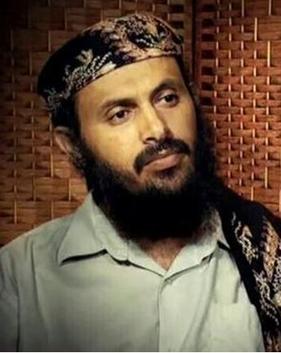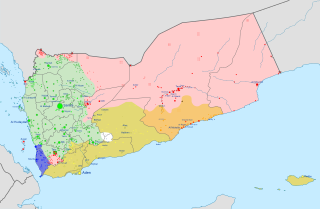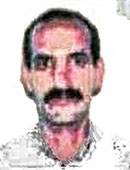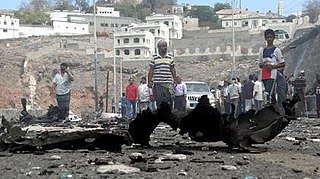
Al-Qaeda is a pan-Islamist militant organization led by Sunni Jihadists who self-identify as a vanguard spearheading a global Islamist revolution to unite the Muslim world under a supra-national Islamic state known as the Caliphate. Its members are mostly composed of Arabs, but also include people from other ethnic groups. Al-Qaeda has mounted attacks on civilian, economic and military targets of America and its allies; such as the 1998 US embassy bombings, the USS Cole bombing and the September 11 attacks. The organization is designated as a terrorist group by NATO, UN Security Council, the European Union, and various countries around the world.

Osama bin Laden was a Saudi-born Islamic dissident and militant leader who was the founder and first general emir of al-Qaeda from 1988 until his death in 2011. Ideologically a pan-Islamist, his organisation is designated as a terrorist group by the United Nations Security Council, the North Atlantic Treaty Organization (NATO), the European Union, and various other countries. He is most widely known as the mind behind the September 11 attacks in the United States.

The bin Laden family, also spelled bin Ladin, is a wealthy family intimately connected with the innermost circles of the Saudi royal family. It is the namesake and controlling shareholder of Saudi Binladin Group, a multinational construction firm. Following the September 11 attacks, the family became the subject of media attention and scrutiny through the activities of Osama bin Laden, the former head of al-Qaeda.

Terrorism in Saudi Arabia has mainly been attributed to Islamic extremists. Their targets included foreign civilians—Westerners affiliated with its oil-based economy—as well as Saudi Arabian civilians and security forces. Anti-Western attacks have occurred in Saudi Arabia dating back to 1995. Saudi Arabia itself has been accused of funding terrorism in other countries, including Syria.
Fahd Mohammed Ahmed al-Quso, also known as Abu Huthaifah, Abu Huthaifah Al-Yemeni, Abu Al-Bara', Abu Hathayfah Al-Adani, Abu Huthaifah Al-Adani, Fahd Mohammed Ahmed Al-Awlaqi, Huthaifah Al-Yemeni, or Abu Huthaifah Al-Abu Al-Bara, was alleged to be a terrorist by American and Yemeni officials, and on the FBI Most Wanted Terrorists list. He was wanted by the FBI, Interpol, and the United States Department of State, which had offered 5 million dollars to anyone with information about him. He was killed by a US drone strike in Yemen on 6 May 2012.

Al-Qaeda in the Arabian Peninsula, abbreviated as AQAP, also known as Ansar al-Sharia in Yemen, is a Sunni Islamist insurgent group, which is part of the al-Qaeda network and primarily active in Yemen and Saudi Arabia. It is considered the most active of al-Qaeda's branches that emerged after the weakening of central leadership.
Osama bin Laden, a militant Islamist and reported founder of al-Qaeda, in conjunction with several other Islamic militant leaders, issued two fatawa – in 1996 and then again in 1998—that military personnel from the United States and allied countries until they withdraw support for Israel and withdraw military forces from Islamic countries. He was indicted in United States federal court for his alleged involvement in the 1998 U.S. embassy bombings in Dar es Salaam, Tanzania and Nairobi, Kenya, and was on the U.S. Federal Bureau of Investigation's Ten Most Wanted Fugitives list until his death.

The international activities of Al-Qaeda includes involvements in Europe, where members of the group have been involved in militant and terrorist activities in several countries. Al-Qaeda has been responsible for or involved in attacks in Western Europe and Russia, including the 2004 Madrid train bombings, 2010 Moscow Metro bombings, 2011 Domodedovo International Airport bombing, and the January 2015 Île-de-France attacks.

Nasir Abdel Karim al-Wuhayshi alias Abu Basir, was a Yemeni Islamist, who served as the leader of al-Qaeda in the Arabian Peninsula (AQAP). Both Saudi Arabia and Yemen considered al-Wuhayshi to be among their most wanted fugitives. In October 2014, the US State Department increased the reward for any information leading to the capture or killing of al-Wuhayshi to US$10 million, the same as ISIS leader Abu Bakr al-Baghdadi. Wuhayshi was killed in a US drone strike in Hadhramaut Governorate of Yemen on 12 June 2015.

Qasim Yahya Mahdi al-Raymi was a Yemeni militant who was the emir of al-Qaeda in the Arabian Peninsula (AQAP). Al-Raymi was one of 23 men who escaped in the 3 February 2006 prison-break in Yemen, along with other notable al-Qaeda members. Al-Raymi was connected to a July 2007 suicide bombing that killed eight Spanish tourists. In 2009, the Yemeni government accused him of being responsible for the running of an al-Qaeda training camp in Abyan province. After serving as AQAP's military commander, al-Raymi was promoted to leader after the death of Nasir al-Wuhayshi on 12 June 2015.

Ibrahim Hassan Tali al-Asiri was a citizen of Saudi Arabia suspected of being chief bomb-maker of al-Qaeda in the Arabian Peninsula. He was reported to have been responsible for making the bombs used by his brother Abdullah al-Asiri in his suicide bombing, the 2009 Christmas Day bomb plot, the 2010 cargo plane bomb plot, and the May 8th 2012 Terror Plot.
The attempted bombing of Northwest Airlines Flight 253 occurred on December 25, 2009, aboard an Airbus A330 as it prepared to land at Detroit Metropolitan Airport following a transatlantic flight from Amsterdam. Attributed to the terrorist organization al-Qaeda in the Arabian Peninsula (AQAP), the act was undertaken by 23-year-old Nigerian national Umar Farouk Abdulmutallab using chemical explosives sewn to his underwear. These circumstances, including the date, led to Abdulmutallab being commonly nicknamed either the "Underwear bomber" or "Christmas Day bomber" by American media outlets.

The Al-Qaeda insurgency in Yemen is an ongoing armed conflict between the Yemeni government, the United States and their allies, and al-Qaeda-affiliated cells in Yemen. It is a part of the Global War on Terror.
At around 9:30 pm on September 11, 2001, George Tenet, director of the Central Intelligence Agency (CIA) told President George W. Bush and U.S. senior officials that the CIA's Counterterrorism Center had determined that Osama bin Laden and al-Qaeda were responsible for the September 11 attacks. Two weeks after the terrorist attacks on September 11, 2001, the Federal Bureau of Investigation connected the hijackers to al-Qaeda, a militant Salafist Islamist multi-national organization. In a number of video, audio, interview and printed statements, senior members of al-Qaeda have also asserted responsibility for organizing the September 11 attacks.
The 2012 Sana'a bombing was a suicide attack on 21 May 2012, against Yemeni Army soldiers practicing for the annual Unity Day military parade in Sana'a, Yemen. The ceremony is carried out every year on 22 May since 1990 to mark the unification of North Yemen and South Yemen as the Republic of Yemen. Responsibility for the attack was claimed by the Al Qaeda in the Arabian Peninsula (AQAP) affiliate Ansar al-Sharia.

Ibrahim Muhammad Salih al-Banna, known as Ibrahim al-Banna is a citizen of Egypt who security officials suspect is a leader in Al Qaeda in the Arabian Peninsula (AQAP). Security officials have repeatedly claimed to have killed him with missiles launched from unmanned aerial vehicles. An October 2011 claim had al-Banna killed, along with six other individuals, including some who were alleged to have been associated with AQAP and at least one who was not. Ibrahim al-Banna was added to the U.S. State Department's Rewards for Justice wanted list on October 14, 2014.
The 1992 Aden hotel bombings were two terrorist bomb attacks carried out by al-Qaeda on December 29, 1992, that were intended to kill United States Marines in Aden, Yemen. It is considered to be the first attack on the United States by Al-Qaeda, though the objective was mostly unsuccessful.

Nasser bin Ali al-Ansi was a senior leader of Al-Qaeda in the Arabian Peninsula (AQAP) based in Yemen. Al-Ansi appeared in many of AQAP's propaganda videos, claiming the kidnap of US photojournalist Luke Somers and the Charlie Hebdo attack in Paris. On 7 May 2015, AQAP announced that al-Ansi was killed in a US drone strike.

The Aden unrest was a conflict between Islamist factions, such as al-Qaeda in the Arabian Peninsula, and Islamic State of Iraq and the Levant's Yemen Branch, against the loyalists of president Abd Rabbuh Mansur Hadi and later to conflict between UAE-backed and Saudi-backed factions within the coalition. In 2017, fighting also broke out between factions aligned with different members of the Saudi-led coalition namely Saudi Arabia-backed Abdrabbuh Mansur Hadi and Al-Islah and UAE-backed separatist Southern Transitional Council and Southern Movement.
al-Qaeda has five distinct phases in its development: its beginnings in the late 1980s, a "wilderness" period in 1990–1996, its "heyday" in 1996–2001, a network period from 2001 to 2005, and a period of fragmentation from 2005 to 2009.












